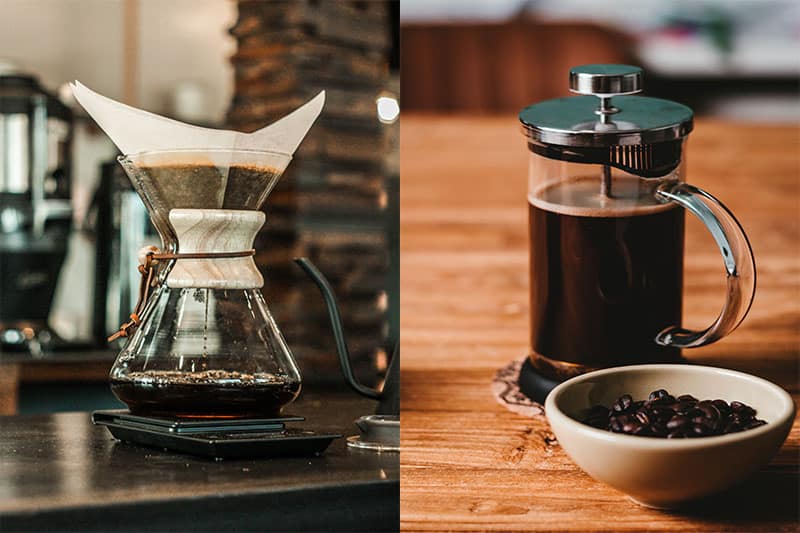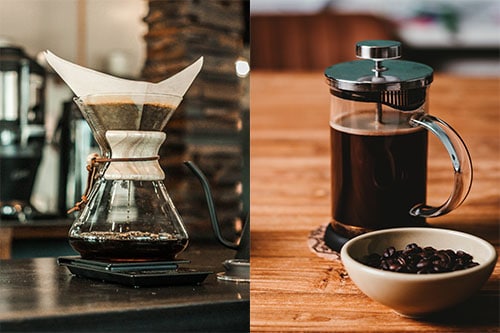
For coffee drinkers, the brewing method is as crucial as the beans themselves. Whether you’re savoring your morning ritual or grabbing an afternoon pick-me-up, the way you brew shapes the flavor, aroma, and experience. Two iconic manual brewing methods, the Chemex and the French Press, stand out for their distinct approaches and loyal followings. But which one suits your lifestyle and taste?
In this guide, we’ll dive into the similarities, differences, and nuances of these brewers to help you decide. From flavor profiles to ease of use, we’ve got you covered with everything you need to know.
What Sets Chemex and French Press Apart?
At their core, the Chemex and French Press differ in their brewing techniques. The Chemex is a pour-over brewer, relying on gravity and a thick paper filter to produce a clean, sediment-free cup. Hot water is poured slowly over medium-coarse coffee grounds, allowing the brew to drip into a glass carafe below. This method, invented in 1941 by chemist Peter Schlumbohm, emphasizes precision and clarity, delivering a bright, delicate coffee that highlights subtle flavor notes.
The French Press, patented in 1929 by Italian designers Attilio Calimani and Giulio Moneta, uses an immersion technique. Coarsely ground coffee steeps in hot water for several minutes before a metal mesh plunger separates the grounds, leaving a full-bodied, robust brew. Known for its simplicity, the French Press extracts oils and fine particles, creating a heavier mouthfeel that appeals to those who love bold flavors.
Both methods are manual, requiring hands-on effort, but they cater to different preferences. Let’s explore how they work, their pros and cons, and what makes each unique.
How Chemex and French Press Brewers Work
Chemex: The Art of Pour-Over
The Chemex is a sleek, hourglass-shaped glass carafe, often adorned with a polished wooden collar and leather tie for easy handling. Its design, inspired by laboratory equipment, is both functional and elegant, making it a favorite in specialty coffee shops. To brew, you place a thick, conical paper filter in the top chamber, add medium-coarse coffee grounds, and pour hot water (ideally 195–205°F) in a slow, circular motion. The coffee blooms, releasing aromas, before dripping into the lower chamber over 4–5 minutes. Techniques like gently swirling the carafe during brewing can ensure even water distribution, but mastering the pour takes practice.
The thick Chemex filter, 20–30% heavier than standard drip filters, is key to its clean taste. It removes oils, acids, and sediment, producing a smooth, aromatic coffee that’s gentle on the stomach. Cleanup is straightforward—discard the filter and rinse the carafe—but the narrow neck can make scrubbing tricky without a bottle brush.
French Press: The Simplicity of Immersion
The French Press, also called a press pot or coffee plunger, is a cylindrical pitcher, typically made of glass or stainless steel, with a metal mesh plunger. To brew, add coarsely ground coffee to the base, pour hot water (195–200°F), and let it steep for 3–4 minutes. Press the plunger down to trap the grounds, and your coffee is ready to pour. Variations, like stirring after the initial pour or avoiding over-pressing the grounds, can refine the flavor, but the process is forgiving for beginners.
Unlike the Chemex, the French Press uses no paper filters, allowing natural oils and fine particles to remain in the brew. This results in a richer, heavier coffee but can leave sediment in the cup, especially if the grind is too fine. Cleaning involves rinsing the grounds from the base and disassembling the plunger, which is easier than the Chemex but messier due to loose grounds.
Comparing Chemex and French Press: Key Factors
To choose between these brewers, consider flavor, ease of use, portability, durability, cost, and versatility. Here’s how they stack up.
Flavor and Strength
Flavor is where the Chemex and French Press diverge most. The Chemex’s paper filter produces a clean, bright cup with low acidity and no sediment, ideal for showcasing delicate notes like citrus or floral tones in African coffees. It’s perfect if you prefer a smooth, nuanced brew or have a sensitive stomach, as filtered coffee may lower cholesterol by removing oils. However, some find the coffee too mellow, lacking the robust body of unfiltered brews.
The French Press, with its metal mesh, retains oils and fine particles, creating a full-bodied, bold coffee with a thicker mouthfeel. It excels with darker roasts or beans from Indonesia or Colombia, where earthy or chocolatey notes shine. The trade-off is a slightly bitter taste and sediment, which can be off-putting for some. If you love a heavy, immersive coffee experience, the French Press delivers.
Ease of Use and Brew Time
The French Press is the simpler of the two. Add grounds, pour water, wait, and plunge—no babysitting required. The process takes about 4 minutes, and you can step away during steeping, making it ideal for busy mornings. Beginners find it foolproof, though over-steeping or pressing too hard can lead to bitterness.
The Chemex demands more attention. You need to rinse the filter, pour water in stages (starting with a bloom phase), and maintain a steady, controlled pour, often using a gooseneck kettle for precision. Brewing takes 4–5 minutes, and you’re actively involved the entire time. While the technique can be meditative, it’s less forgiving and may intimidate novices.
Portability and Durability
For portability, the French Press has the edge. Available in stainless steel, ceramic, or plastic, it’s sturdier and better suited for travel or camping. Compact models fit easily in a backpack, and the lack of paper filters simplifies packing. Glass French Presses are less durable but still less fragile than the Chemex.
The Chemex, made of borosilicate glass, is elegant but breakable. Its bulky, hourglass shape isn’t travel-friendly, and you’d need to carry proprietary filters, which adds hassle. It’s best suited for home use, where its aesthetic can shine on a kitchen counter.
Cost and Maintenance
Cost is a deciding factor for many. A basic French Press, like a Bodum, starts at $20–$30, with high-end models reaching $100–$200 for premium materials. Once purchased, there are no ongoing costs, as it requires no filters. This makes it budget-friendly and eco-friendly.
A six-cup Chemex retails for $40–$50, with hand-blown versions costing up to $125. The real expense comes from Chemex-specific paper filters, priced at about $0.08 each in 2025. Over time, filter costs add up, and their disposal impacts sustainability. Both brewers are more affordable than espresso machines, but the French Press is the economical choice.
Versatility
The French Press is more versatile. Beyond hot coffee, it can brew cold brew, tea, or even froth milk. Its design accommodates various grind sizes (though coarse is best) and steeping times, offering flexibility for experimentation.
The Chemex is less adaptable, primarily suited for hot pour-over coffee. Its thick filters and specific grind size (medium-coarse) limit versatility, though it excels at delivering a consistent, high-quality pour-over experience.
Cleanup
Cleanup is a practical concern. The Chemex is easier in some ways—remove the filter, and the grounds are gone. However, the carafe’s shape makes thorough cleaning challenging without a bottle brush, and the wooden collar isn’t dishwasher-safe. The French Press requires scooping or rinsing wet grounds, which can clog sinks without a garbage disposal. The plunger’s mesh filter also needs occasional deep cleaning to remove oil buildup, but the wide pitcher is easier to scrub.
Chemex vs. French Press: At a Glance
To help you compare, here’s a table summarizing the key differences:
| Feature | Chemex | French Press |
|---|---|---|
| Brewing Method | Pour-over with paper filter | Immersion with metal mesh filter |
| Flavor Profile | Clean, bright, low acidity, sediment-free | Full-bodied, bold, oily, some sediment |
| Grind Size | Medium-coarse | Coarse |
| Brew Time | 4–5 minutes (active pouring) | 3–4 minutes (mostly passive) |
| Ease of Use | Requires skill and attention | Simple, beginner-friendly |
| Portability | Fragile, bulky, requires filters | Sturdy, compact, no filters needed |
| Durability | Glass, prone to breaking | Stainless steel or glass, more durable |
| Cost | $40–$125 + $0.08/filter | $20–$200, no ongoing costs |
| Cleanup | Easy filter disposal, tricky carafe shape | Messy grounds, easier to scrub pitcher |
| Versatility | Primarily hot pour-over coffee | Hot coffee, cold brew, tea, more flexible |
Recent Insights and Reviews
Recent discussions among coffee enthusiasts highlight the ongoing debate between these brewers. A recent review from Corner Coffee Store praises the Chemex for its health benefits, noting that filtered coffee may reduce cholesterol, and its aesthetic appeal. However, it acknowledges the French Press’s simplicity and durability for everyday use.
A Reddit thread suggests that Chemex excels at highlighting nuanced flavors, while the French Press’s sediment adds complexity that some prefer. These insights align with the consensus that neither brewer is “better”—it’s about what you value in your coffee.
Which Brewer Should You Choose?
Choosing between a Chemex and a French Press boils down to your priorities. If you crave a clean, aromatic cup with minimal bitterness and don’t mind a learning curve, the Chemex is your match. Its elegant design and sediment-free coffee make it ideal for savoring light roasts or hosting brunch. However, it’s less portable, more expensive, and requires ongoing filter purchases.
If bold, full-bodied coffee is your style and you want a simple, budget-friendly option, go for the French Press. Its versatility, durability, and ease of use make it perfect for busy mornings, travel, or experimenting with cold brew. Be prepared for sediment and a messier cleanup, though.
Both brewers elevate your coffee game beyond standard drip machines, offering a hands-on experience that feels rewarding. Try a light Ethiopian roast with a Chemex to taste its floral notes, or pair a dark Colombian blend with a French Press for a rich, chocolatey kick. Whichever you choose, you’re in for a delicious cup.

